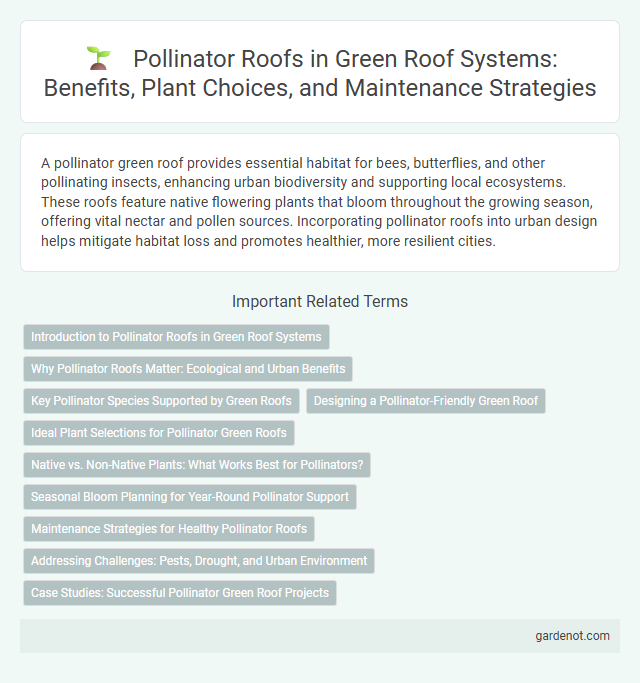A pollinator green roof provides essential habitat for bees, butterflies, and other pollinating insects, enhancing urban biodiversity and supporting local ecosystems. These roofs feature native flowering plants that bloom throughout the growing season, offering vital nectar and pollen sources. Incorporating pollinator roofs into urban design helps mitigate habitat loss and promotes healthier, more resilient cities.
Introduction to Pollinator Roofs in Green Roof Systems
Pollinator roofs are specialized green roof systems designed to support a variety of pollinating insects such as bees, butterflies, and moths by incorporating native flowering plants that provide essential nectar and pollen resources. These roofs enhance urban biodiversity, improve ecosystem services, and contribute to healthier pollinator populations critical for food production and plant reproduction. Integrating pollinator-friendly vegetation within green roofs creates sustainable habitats that mitigate the decline of pollinator species while offering environmental benefits like stormwater management and temperature regulation.
Why Pollinator Roofs Matter: Ecological and Urban Benefits
Pollinator roofs provide essential habitats for bees, butterflies, and other pollinating insects, supporting biodiversity in urban environments. By enhancing local ecosystems, these green roofs promote plant reproduction and improve food security. Their presence also helps mitigate urban heat island effects and improve air quality, making cities more sustainable and resilient.
Key Pollinator Species Supported by Green Roofs
Green roofs designed as pollinator habitats primarily support key species such as honeybees (Apis mellifera), bumblebees (Bombus spp.), and native solitary bees including mining bees (Andrena spp.) and mason bees (Osmia spp.). These species benefit from the diverse flowering plants and nesting sites provided by green roofs, which enhance urban biodiversity and pollination services. By fostering habitats for butterflies like monarchs (Danaus plexippus) and hoverflies (Syrphidae), pollinator roofs contribute significantly to ecosystem resilience and food security in urban environments.
Designing a Pollinator-Friendly Green Roof
Designing a pollinator-friendly green roof requires selecting native flowering plants that provide nectar and pollen throughout the growing season, supporting bees, butterflies, and other essential pollinators. Incorporating diverse plant species with staggered bloom times enhances biodiversity and ensures continuous food sources, while lightweight, well-drained growing media promotes healthy root development. Integrating nesting habitats, such as bee hotels or bare soil patches, further supports pollinator populations and fosters a thriving rooftop ecosystem.
Ideal Plant Selections for Pollinator Green Roofs
Ideal plant selections for pollinator green roofs include native wildflowers such as Echinacea purpurea, Asclepias tuberosa, and Solidago canadensis, which provide nectar and pollen essential for bees, butterflies, and other pollinators. Incorporating a diverse mix of flowering species with staggered bloom times ensures continuous food sources throughout the growing season, enhancing habitat quality. Deep-rooted sedums and drought-tolerant grasses complement these plants by supporting soil stability and moisture retention, critical for long-term roof ecosystem health.
Native vs. Non-Native Plants: What Works Best for Pollinators?
Pollinator roofs featuring native plants provide essential nectar and pollen sources tailored to local pollinators, supporting biodiversity and ecosystem health more effectively than non-native species. Native plants have co-evolved with regional pollinators, ensuring higher visitation rates and better reproduction for both plants and pollinators. Non-native plants may offer some resources but often lack the specialized relationships needed for optimal pollinator support on green roofs.
Seasonal Bloom Planning for Year-Round Pollinator Support
Pollinator roofs designed with seasonal bloom planning ensure continuous nectar and pollen availability throughout the year, supporting diverse pollinator species. Selecting native and climate-adapted plants that flower in succession guarantees habitat stability and enhances urban biodiversity. Integrating early spring bulbs, summer perennials, and late autumn bloomers maximizes floral resources for bees, butterflies, and other pollinators.
Maintenance Strategies for Healthy Pollinator Roofs
Maintaining a healthy pollinator roof requires regular monitoring of native plant health and timely removal of invasive species to support diverse pollinator populations. Implementing seasonal pruning and supplemental watering during dry periods ensures optimal flowering and habitat conditions. Soil fertility should be managed through organic amendments to sustain nutrient levels critical for pollinator-attracting vegetation.
Addressing Challenges: Pests, Drought, and Urban Environment
Pollinator roofs combat pests through integrated pest management techniques, including planting native flowering species that attract beneficial insects and deter harmful ones. These roofs utilize drought-resistant plants and efficient irrigation systems to maintain resilience during dry urban conditions, reducing water consumption significantly. Incorporating diverse vegetation and microhabitats supports pollinator health while mitigating the harsh effects of urban heat islands and pollution.
Case Studies: Successful Pollinator Green Roof Projects
Case studies of successful pollinator green roof projects demonstrate significant increases in urban biodiversity by providing habitats for bees, butterflies, and other essential pollinators. Notable examples include the Chicago City Hall green roof, which enhanced native plant growth and supported over 40 pollinator species, and the Vancouver Convention Centre's extensive pollinator-friendly vegetation that improved local ecosystem resilience. These projects consistently show that strategically selected native plants and proper maintenance can optimize pollinator activity while contributing to urban sustainability goals.
Pollinator roof Infographic

 gardenot.com
gardenot.com